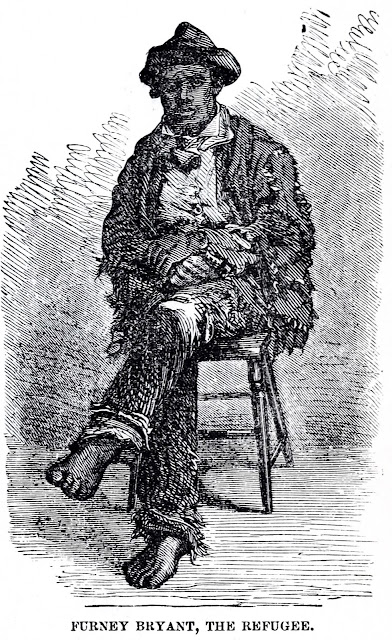“A Typical Negro”
WE publish herewith three portraits, from photographs by M'Pherson and Oliver, of the negro GORDON, who escaped from his master in Mississippi, and came into our lines at Baton Rouge in March last. One of these portraits represents the man as he entered our lines, with clothes torn and covered with mud and dirt from his long race through the swamps and bayous, chased as he had been for days and nights by his master with several neighbors and a pack of blood-hounds; another shows him as he underwent the surgical examination previous to being mustered into the service --his back furrowed and scarred with the traces of a whipping administered on Christmas-day last; and the third represents him in United States uniform, bearing the musket and prepared for duty. -- Harper's Weekly
Together, these three wood engravings tell a highly effective, though perhaps somewhat fictionalized, story of the transformation of an enslaved scourged African American Mississippian into a Free Union Soldier. Harper's includes a description of Gordon's cleverness during his harrowing escape and his heroism in U.S. service.
This negro displayed unusual intelligence and in order to foil the scent of the blood-hounds who were chasing him he took from his plantation onions, which he carried in his pockets. After crossing each creek or swamp he rubbed his body freely with these onions, and thus, no doubt, frequently threw the dogs off the scent.At one time in Louisiana he served our troops as guide, and on one expedition was unfortunately taken prisoner by the rebels, who, infuriated beyond measure, tied him up and beat him, leaving him for dead. He came to life, however, and once more made his escape to our lines. -- Harper's Weekly
Two of the photographs on which Harper's wood engravings are based still exist. The main picture is a version of an extremely famous photo distributed during the Civil War in the form of cartes de visite. This CdV is an 1864 copy by C. Seaver, Jr., after the 1863 McPherson & Oliver original.
This picture was very influential during the war and remains an important and familiar documentary photo.
A photo of “Gordon as He Came to Our Lines” also existed as a carte de visite. (This one sold for $1,527.50 at Cowan's Auctions in 2008.)
The same wood engravings used to illustrate Gordon “As He Entered Our Lines” and “In His Uniform as as U. S. Soldier” were re-purposed in Vincent Colyer's 1864 book, Report of the Services Rendered by the Freed People to the United States Army: in North Carolina, in the spring of 1862, after the battle of Newbern. This time, they show Furney Bryant before and after becoming a member of the USCT.
Peter
Another similar but not identical photo, of the same man, belongs to the National Archives.
Baton Rouge, La. [Louisiana], April 2, 1863.
Ten days from to-day I left the plantation. Overseer Artayou Carrier whipped me. My master was not present. I don't remember the whipping. I was two months in bed sore from the whipping and my senses began to come--I was sort of crazy. I tried to shoot everybody. They said so, I did not know. I did not know that I had attempted to shoot every one; they told me so. I burned up all my clothes; but I don't remember that. I never was this way (crazy) before. I don't know what make me come that way (crazy). My master come after I was whipped; saw me in bed; he discharged the overseer. They told me I attempted to shoot my wife the first one; I did not shoot any one; I did not harm any one. My master's Capt. John Lyon, cotton planter, on Atchafalya [Atchafalaya], near Washington, La. Whipped two months before Christmas.
The very words of poor Peter, taken as he sat for his picture.
Will Smith recreates the photo of “Whipped Peter”
in Emancipation (2022).
=======================================================================
Update 2025: The photo of “The Scourged Back” became a target of Donald Trump's project to remove discussion of slavery from exhibits in National Parks. See The Washington Post Sept. 15, 2025, “National park to remove photo of enslaved man’s scars”. Note that difference has been split and the subject of the photo is identified as “Peter Gordon”.
“ ‘The Scourged Back’ shows the scarred back of escaped slave Peter Gordon in Louisiana, 1863. (McPherson & Oliver/National Gallery of Art)” -- Washington Post.














No comments:
Post a Comment